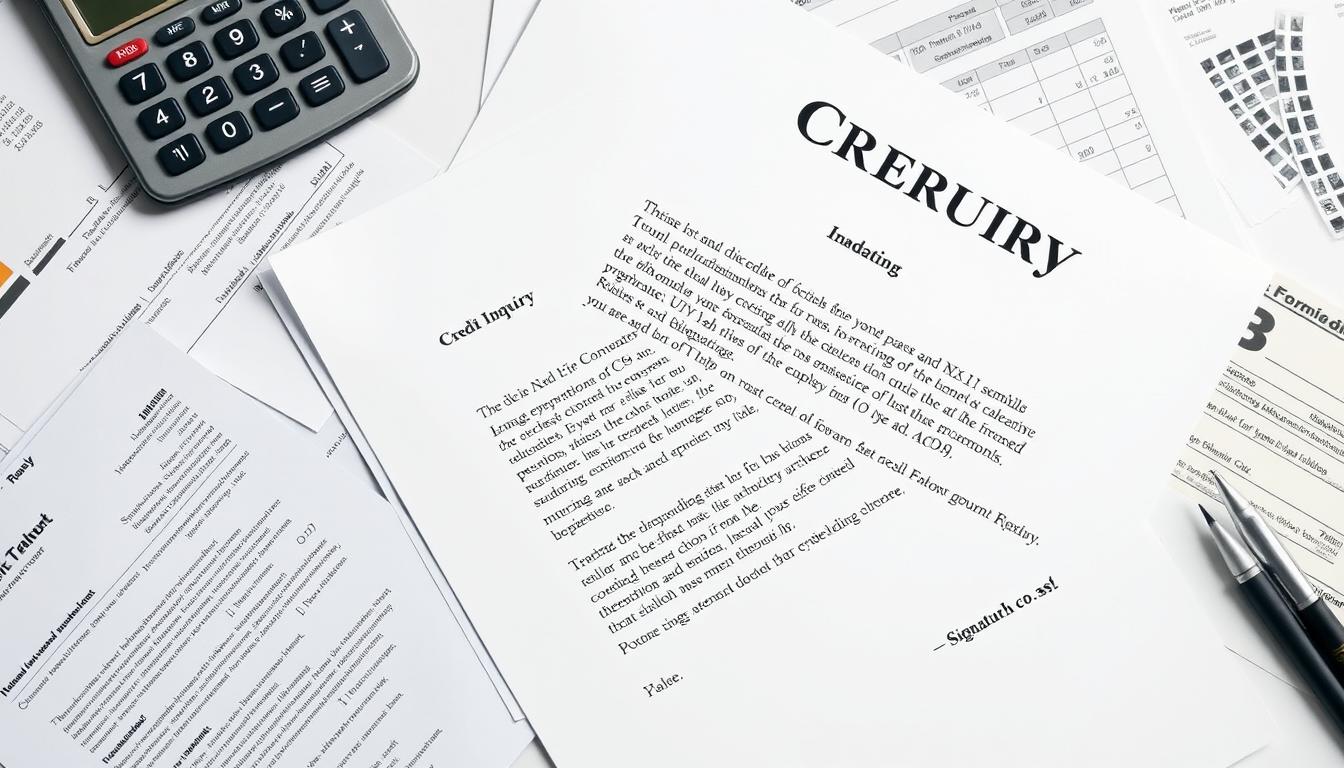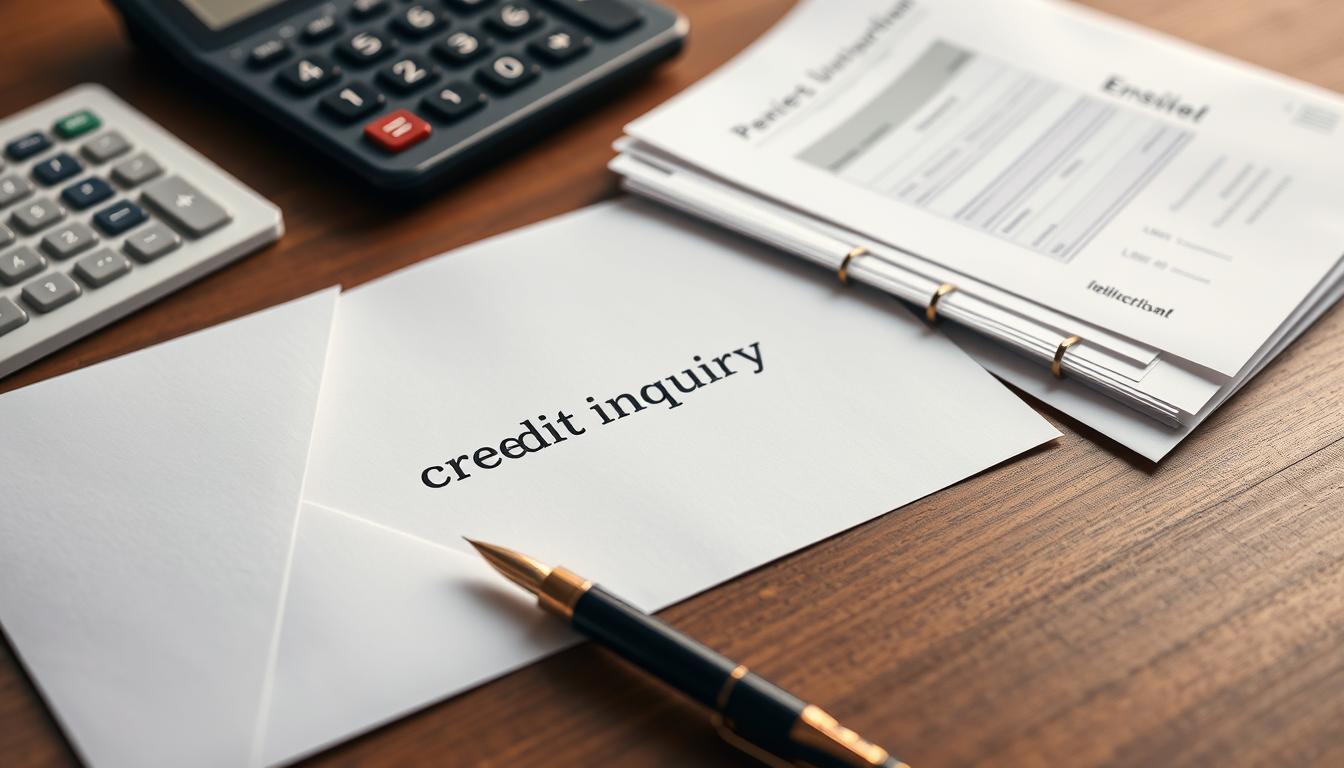Credit reports and scores can be tricky to understand. But knowing about credit inquiries is key for good finances. This guide helps you write a credit inquiry letter of explanation. You’ll learn to address inquiries and improve your credit score. This will help make your credit applications smoother.
Key Takeaways
- Understand the different types of credit inquiries and their impact on your credit score
- Learn when a credit inquiry letter of explanation is necessary
- Discover the key components of an effective credit inquiry letter
- Gain tips for writing a compelling credit inquiry letter
- Explore the process of submitting and following up on your credit inquiry letter
Understanding Credit Inquiries and Their Impact
Credit inquiries play a key role in credit applications. They can affect your credit score significantly. Knowing how they work is vital for your financial health.
Types of Credit Inquiries
There are two main types of credit inquiries: hard and soft. Hard inquiries happen when you apply for new credit. These can temporarily lower your credit score.
Soft inquiries occur during background checks or account monitoring. They don’t affect your credit score at all.
How Credit Inquiries Affect Your Score
Several factors influence how inquiries impact your credit score. These include the number, timing, and nature of inquiries. Multiple hard inquiries in a short time can have a bigger effect.
The type of credit you’re applying for matters too. Mortgage, auto, and student loan applications usually have less impact. Credit card or personal loan applications may affect your score more.
Credit report errors can harm your score unfairly. These might include unauthorized or inaccurate inquiries. If you spot any errors, dispute them quickly to protect your credit.
When Do You Need a Credit Inquiry Letter of Explanation?
Understanding credit inquiry letters of explanation can help you manage your financial health. These documents address credit applications, report errors, and unauthorized inquiries.
You may need a letter when unauthorized inquiries appear on your report. These “hard pulls” can harm your credit score. A well-crafted letter helps you control credit report error correction.
Letters are also useful when applying for new credit or loans. Lenders often need clarity on credit applications. A credit application guidance letter provides context about your financial situation.
A credit inquiry letter of explanation is a key financial tool. It helps you address credit issues proactively. This ensures your credit report accurately reflects your financial history.
“Taking control of your credit report is the first step towards achieving your financial goals.”

Key Components of an Effective Credit Inquiry Letter
A well-crafted credit inquiry letter requires several essential elements. These components help communicate your story effectively. They also address any concerns the credit bureaus might have.
Personal Information
Begin your letter with your personal details. Include your full name, current address, and contact information. This helps the credit bureau easily reference your credit file.
Inquiry Details
Clearly outline the specific credit inquiry you’re addressing. Provide the date of the inquiry and the name of the requesting company. Also, briefly describe the circumstances surrounding the inquiry.
Clear and Concise Explanation
The explanation is the heart of your credit inquiry letter. Craft an honest account of the events leading to the inquiry. Focus on providing a straightforward narrative that addresses potential concerns.
Avoid excessive details or vague statements. Keep your explanation clear and compelling.
| Key Component | Description |
|---|---|
| Personal Information | Include your full name, current address, and contact details to establish your identity. |
| Inquiry Details | Provide the date, the company that made the inquiry, and a brief description of the circumstances. |
| Clear and Concise Explanation | Craft a straightforward and compelling narrative that addresses any concerns the credit bureau may have. |
Including these key components can improve your chances of a favorable outcome. It can also protect your credit score from unauthorized or misunderstood inquiries.
Credit Inquiry Letter of Explanation Template
A credit inquiry letter is vital for addressing errors on your credit report. Our template helps you craft a clear and effective letter. It covers all the key elements needed for a well-structured explanation.
This template is easy to customize for your specific situation. You can use it to address errors or update your credit file. It ensures your letter is concise and includes all necessary information.
Key Elements of the Template
- Personal Information: Start your letter by clearly stating your name, current address, and any relevant contact information.
- Inquiry Details: Provide specifics about the credit inquiry in question, including the date, the company that made the inquiry, and the reason for the inquiry, if known.
- Explanation: Offer a clear and straightforward explanation for the credit inquiry, addressing any discrepancies or errors that may have occurred.
- Supporting Documentation: If applicable, include copies of any relevant documents, such as credit reports or receipts, to substantiate your explanation.
- Request for Action: Conclude your letter by politely requesting the necessary action, such as the removal of the unauthorized inquiry or the correction of any errors in your credit file.
Our template ensures your letter is well-structured and informative. It increases your chances of resolving credit-related issues effectively. You can communicate your concerns clearly and persuasively.

“A well-crafted credit inquiry letter can be the key to resolving credit report errors and maintaining the integrity of your credit file.”
The success of your letter depends on providing accurate information. A clear explanation and professional tone are crucial. This template guides you in addressing credit issues effectively.
By using our template, you’ll be better equipped to handle credit-related problems. It helps you take control of your financial future with confidence.
Tips for Writing a Compelling Credit Inquiry Letter
A strong credit inquiry letter balances facts and honesty with supporting evidence. These tips will help you create a powerful letter that addresses the inquiry effectively.
Be Factual and Honest
Always be truthful about the circumstances surrounding the inquiry. Explain clearly what led to the credit inquiry. Avoid exaggerations and vague statements.
Your goal is to present a factual account. This allows the lender to evaluate your situation objectively.
Provide Supporting Documentation
Gather relevant documents that back up your explanation. These may include billing statements, receipts, or other related paperwork.
Tangible evidence shows the legitimacy of your situation. It increases the chances of a favorable outcome.
A successful letter combines facts with solid documentation. This approach effectively addresses the inquiry and helps protect your credit score.
Submitting Your Credit Inquiry Letter
Crafting a detailed credit inquiry letter is just the first step. Proper submission is crucial for addressing concerns and updating your credit file accurately.
Where to Send the Letter
Send your letter to the credit reporting agency (CRA) responsible for the inaccurate inquiry. The three major CRAs are Experian, Equifax, and TransUnion.
Find their mailing addresses on their websites or online resources. You may also send a copy to the specific lender or company involved.
This approach helps streamline the credit report dispute process. It ensures all parties are aware of the issue at hand.
Follow-Up Process
After submitting your credit inquiry letter, keep track of your case. CRAs must investigate and respond within 30-45 days.
Check the status by contacting the CRA directly. You can also use their online dispute resolution tools.
If the inquiry is invalid, the CRA will update your credit file. This can boost your credit score and prevent negative impacts.

Stay proactive in the credit inquiry letter submission process. This approach helps resolve credit report issues effectively.
By following these steps, you can take control of your credit. Maintaining a healthy financial profile becomes much easier.
Disputing Unauthorized Credit Inquiries
Found unauthorized credit inquiries on your report? Don’t worry. You can dispute these and potentially boost your score. The process might seem tough, but you can challenge any credit inquiry that doesn’t belong.
First, gather info about the unauthorized inquiries. Note the company name, date, and other key details. This info helps you create a detailed credit inquiry removal request for credit bureaus.
- Draft a letter outlining the unauthorized inquiries and your request for their removal.
- Provide supporting documentation, such as copies of your credit report or any communication from the company that made the inquiry.
- Submit your dispute to the appropriate credit bureau(s) via certified mail, ensuring you have a paper trail.
- Follow up with the credit bureau(s) within 30-45 days to verify the status of your dispute.
Stay persistent when disputing credit inquiries. If the first try fails, escalate and provide more evidence. Keep at it to remove unauthorized inquiries and improve your credit score.
“Protecting the accuracy and integrity of your credit report is crucial for maintaining a healthy financial future.”
You have the right to an accurate credit report. Address unauthorized inquiries promptly. This helps you control your credit profile and opens doors to better financial opportunities.
Monitoring and Maintaining Your Credit
Keeping tabs on your credit health is vital for financial success. Regular credit monitoring and smart management can boost your credit profile. These habits help optimize your credit utilization.
Reviewing your credit report updates is key to credit monitoring. Check reports from Experian, Equifax, and TransUnion often. This helps spot issues that could harm your credit score.
Address any errors or unauthorized activities promptly. Doing so protects your credit standing and financial well-being.
- Set up credit monitoring alerts to receive notifications about changes to your credit file.
- Review your credit reports at least once a year to ensure accuracy and identify any potential issues.
- Dispute any errors or unauthorized items with the respective credit bureaus to have them removed from your credit history.
Credit utilization is crucial for credit maintenance. It’s the ratio of balances to credit limits. Keeping utilization below 30% shows responsible credit management.
Low utilization can improve your creditworthiness. It’s a key factor in determining your overall credit score.
| Credit Utilization Ratio | Impact on Credit Score |
|---|---|
| Below 30% | Positive impact on credit score |
| Above 30% | Negative impact on credit score |
Monitor your credit regularly and address issues promptly. Optimize your credit utilization for a healthy profile. These steps pave the way for long-term financial success.

Proactive Credit Management Strategies
A healthy credit profile demands proactive steps. Smart strategies can prevent credit inquiries and boost your score. Let’s explore effective ways to strengthen your financial standing.
Regular Credit Monitoring
Check your credit reports often to spot discrepancies. Use free monitoring services to catch potential issues early. This vigilance helps protect your financial health.
Dispute Inaccuracies
Notice errors in your credit report? Dispute them with credit bureaus right away. Provide proof and follow proper channels for timely corrections.
Credit Utilization Management
Keep credit card balances low compared to your limits. Aim for a utilization ratio of 30% or less. This shows responsible credit use and positively impacts your score.
Diversify Your Credit Mix
A varied mix of credit accounts can improve your score. This includes credit cards, loans, and mortgages. It shows lenders you manage different credit types well.
| Credit Management Strategy | Potential Impact on Credit Score |
|---|---|
| Regular Credit Monitoring | Helps identify and address issues early, preventing further damage to your credit score. |
| Dispute Inaccuracies | Correcting errors can lead to a significant improvement in your credit score. |
| Credit Utilization Management | Maintaining a low credit utilization ratio can positively impact your credit score. |
| Diversify Your Credit Mix | Having a varied credit portfolio demonstrates responsible credit management. |
These credit management strategies protect your credit profile actively. They help improve your credit score and ensure accuracy of your credit history. Stay alert and take charge of your financial future.
Conclusion
Credit inquiries can impact your credit score significantly. Understanding their types and when to explain them is crucial. This knowledge empowers you to navigate credit matters confidently.
Crafting an effective credit inquiry letter is vital for a healthy credit profile. Clear explanations and supporting documents can address unauthorized inquiries. This protects your credit score and simplifies future credit applications.
We’ve explored strategies for credit score improvement and proactive credit management. Regular credit report monitoring and best practices can help you control your financial future.
A strong credit report and high credit score are key to favorable loan terms. They also help in accessing credit and achieving financial goals. Following this guide can help you build a resilient credit profile.
“Maintaining a healthy credit profile is a journey, not a destination. With the right strategies and a proactive approach, you can unlock a world of financial possibilities.”
This guide has armed you with tools to handle credit inquiries and disputes. Taking action on these strategies can improve your credit score. It can also secure a brighter financial future for you.
Additional Resources
Our credit resources help you understand and improve your credit health. We offer guides on credit reports and tools to boost your score. Learn strategies for maintaining a healthy financial profile.
Our library provides guidance on decoding credit report complexities. You’ll find effective credit-building techniques here. Take control of your credit and secure a brighter financial future.
We’ve assembled resources for credit score improvement and management. Our team’s information empowers you throughout your credit journey. Explore our collection to understand and elevate your credit profile confidently.

